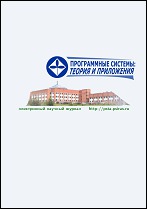|
|
Program Systems: Theory and Applications, 2014, Volume 5, Issue 1, Pages 191–244
(Mi ps114)
|
 |
|
|
This article is cited in 2 scientific papers (total in 2 papers)
Hardware, software and distributed supercomputer systems
Predictive modeling and simulation of properties and multi-scale processes in materials science. Tasks for Exaflops-era supercomputers
A. Yu. Kuksinab, A. V. Lankinba, I. V. Morozovbac, H. E. Normanab, N. D. Orekhovab, V. V. Pisarevab, G. S. Smirnovab, S. V. Starikovab, V. V. Stegailovab, A. V. Timofeevcab
a Joint Institute for High Temperatures, Russian Academy of Sciences
b Moscow Institute of Physics and Technology
c Higher School of Economics
Abstract:
The approach is developed which allows to find out the problems which
need for their solution exaflops supercomputers. The approach is demonstrated at
the examples of topical problems of material science, condense matter and dense
plasma physics where atomistic modeling is necessary to apply. The correspondence
is established for each problem between phenomena studied and computational
cores number needed. Modeling parallel programs scalability is shown as well as
perspective of the modeling methods predictive ability extension with the increase of
computational cores number and / or use of special architecture (graphical processing
units).
The following problems are considered: 1) surface modification at processing of
metals by sub-picosecond laser pulses, 2) radiation-induced aging of nuclear reactors
fuels, 3) phase transition kinetics in metastable liquids, 4) methane and hydrogen
gas hydrates structures and computation of their properties, 5) polymers multiscale
models, 6) dusty plasmas, 7)ion recombination in liquid and gaseous dielectric media
at discharge break and relaxation, 8) electric double layer between graphite and
electrolyte, influence of electron-hole electrode structure on capacity. Predictive
modeling reliability is checked by comparisons with experiments.
The modeling methods hierarchy, which is necessary to describe properties of
matter at different space and time scales, is considered in frames of the multiscale
approach. Density functional theory (quantum molecular dynamics) is applied at
the deepest nm/pm scale to model electron dynamics and to construct effective
interaction potentials between particles. Classical molecular dynamics modeling is
used to treat moving atoms systems up to micro-scale. Kinetic theory and continuum
mechanics is used to proceed with micro-scale. Particular attention is paid to the
exchange of information between different scales, i.e. to the unified description of
systems from nano to micro levels. Parallelization efficiency comparison is performed
for three classes of problems at fat tree and torus topologies (in Russian).
Key words and phrases:
atomistic modeling, electronic structure, molecular dynamics, multiscale modelling, radiation aging, laser ablation, nucleation, hydrates, polymers, dusty plasma, electrochemistry, parallel efficiency.
Citation:
A. Yu. Kuksin, A. V. Lankin, I. V. Morozov, H. E. Norman, N. D. Orekhov, V. V. Pisarev, G. S. Smirnov, S. V. Starikov, V. V. Stegailov, A. V. Timofeev, “Predictive modeling and simulation of properties and multi-scale processes in materials science. Tasks for Exaflops-era supercomputers”, Program Systems: Theory and Applications, 5:1 (2014), 191–244
Linking options:
https://www.mathnet.ru/eng/ps114 https://www.mathnet.ru/eng/ps/v5/i1/p191
|

| Statistics & downloads: |
| Abstract page: | 454 | | Full-text PDF : | 179 | | References: | 53 |
|




 Contact us:
Contact us: Terms of Use
Terms of Use
 Registration to the website
Registration to the website Logotypes
Logotypes







 Citation in format
Citation in format 
